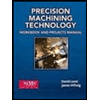
Precision Machining Technology
3rd Edition
ISBN: 9781337795302
Author: Peter, Hoffman.
Publisher: Cengage Learning,
expand_more
expand_more
format_list_bulleted
Textbook Question
Chapter 7.2, Problem 6RQ
The grade of a wheel describes its __________ on a scale from __________ to __________.
Expert Solution & Answer
Want to see the full answer?
Check out a sample textbook solution
Students have asked these similar questions
The u component of F1 is_________while the u component of F2 is__________. Assuming the vertical direction is positive upward and negative downward. the vertical component of F1 is_______and based on the __________degree angle measure. The vertical component of F2 is_____and based on the__________________degree angle measure.
The resultant's vertical component will be____________while the u component will depend on the magnitude of F1 and F2's u component. Choice "a" is WRONG when i did it
a. positive,negative,30,postive,45,negative (X)
b. positive,negative,negative,30,negative,45,positive
c. positive,negative,negative,30,negative,65,negative
d. negative,positive,negative,30,negative,45,negative
QUESTION 2
Note: Work accurately to two decimal places. Use a point (.) as your decimal place holder.
A horizontal single cylinder engine has a cylinder diameter of 75 mm, a radius of crankshaft 70 mm and a connecting rod length of 393 mm. The mass of the piston is 7 kg and that of the connecting rod is 7 kg. The centre of mass of the connecting rod is 199 mm from the big end bearing centre and has a radius of gyration k = 254 mm through the centre of gravity of the connecting rod. The effect of the connecting rod mass may be allowed for by apportioning it between the two ends. When the crank is 54° from the top dead centre position on the compression stroke (piston moving towards (TDC) the gas pressure is 849 kPa. The crankshaft rotates at a rotational speed of 924 rpm.
2.1 Calculate the reciprocating mass (R) of the system [answer in kg].
2.2 Calculate the kinetic energy of rotation of the connecting rod (E), through its centre of gravity [answer in Joule].
2.3 Calculate the…
In the context of our teaching and learning, which
one of the below statements is mostly correct
about in the creation of detailed design of a
component?
In deciding the tolerance, the guidance is the
tighter the better.
I am the designer, so I decide the required
tolerance as l like.
The tolerance is determined by the function.
The chance to manufacture component to the
exact size is like to win a lottery. I would enjoy
winning a lottery, so I should specify all the
dimensions as exact, no tolerance to be
considered at all.
Chapter 7 Solutions
Precision Machining Technology
Ch. 7.1 - What are three benefits of precision grinding?Ch. 7.1 - What is the major use of the surface grinder?Ch. 7.1 - What are the two spindle types used for surface...Ch. 7.1 - What are the two types of table movements used for...Ch. 7.1 - Label the parts of the surface grinder.Ch. 7.1 - What are three types of cylindrical grinders?Ch. 7.1 - Tool and cutter grinders can be used to _______...Ch. 7.2 - What wheel shapes are commonly used for surface...Ch. 7.2 - What abrasive is commonly used to grind steels?Ch. 7.2 - What abrasive is used to grind nonferrous metals,...
Ch. 7.2 - What does CBN stand for?Ch. 7.2 - What superabrasive is a good choice for grinding...Ch. 7.2 - The grade of a wheel describes its __________ on a...Ch. 7.2 - Prob. 7RQCh. 7.2 - Prob. 8RQCh. 7.2 - Generally, harder wheels should be used to grind...Ch. 7.2 - Wheel A: 32A60H8V Wheel B: 39C100L6V What is the...Ch. 7.2 - Wheel A: 32A60H8V Wheel B: 39C100L6V Which wheel...Ch. 7.2 - Wheel A: 32A60H8V Wheel B: 39C100L6V Which wheel...Ch. 7.2 - Wheel A: 32A60H8V Wheel B: 39C100L6V Which wheel...Ch. 7.2 - Wheel A: 32A60H8V Wheel B: 39C100L6V What type of...Ch. 7.3 - List five surface grinder safety guidelines.Ch. 7.3 - What should be done to every grinding wheel before...Ch. 7.3 - When using a magnetic workholding device, the work...Ch. 7.3 - When using a magnetic chuck to hold a workpiece...Ch. 7.3 - Describe the difference between wheel truing and...Ch. 7.3 - What tool is used to true and dress an aluminum...Ch. 7.3 - How is a CBN wheel trued and dressed?Ch. 7.3 - Depth-of-cut range for surface grinding is: a....Ch. 7.3 - What should be done to a magnetic chuck when it...Ch. 7.3 - What workholding device can extend the magnetic...Ch. 7.3 - What workholding device can be used when grinding...Ch. 7.3 - Briefly describe the method for grinding two...Ch. 7.3 - List three types of workpiece features that can be...Ch. 7.3 - List three possible solutions to eliminate bum...Ch. 7.3 - What can cause scratches on the surface of a...
Knowledge Booster
Learn more about
Need a deep-dive on the concept behind this application? Look no further. Learn more about this topic, mechanical-engineering and related others by exploring similar questions and additional content below.Similar questions
- estion 4 What is the value of the dimension measured on the following Vernier Caliper in mm? t yet swered rked out of cm 00 3 4 6 7 89 10 Flag question Main Scale Vernier Scale Select one: O a. 1.65 mm O b. 11.65 mm O c. 9.65 mm O d. 10.65 uestion 5 Determine the rotational speed in rpm of the shaft of diameter 30 mm if the cutting sneed 50 m (minarrow_forwardSolve it correctly as fast as !!arrow_forwardQuestion 5 Assuming there is no wheel slippage, what is the wheel rotation speed in revolutions per minute of a car moving in a straight line at constant speed for 5 min over a distance of 181 m? The wheels have a diameter of 450 mm. Give your answer in meters rounded to two decimal places, use PI = 3.14. Do not write the unit in your answer.arrow_forward
- In the future, you will pursue a career in a motorcycle manufacturing company as a designer. The unit head of the production team instructed the design team to create a new design of wheel and ask to submit a proposal.The proposal must consider the following standards: 1. The number of spokes ranges from 5 to 122. Distance of each spoke should be equal3. Indicate the exact distance in radians of one spoke to the other. The distance is measured from the center of the end of one spoke to the center of the end of the next spoke.arrow_forwardRefer to the 1.914 dimension. A) Where is the tolerance specified ? _________________________________ B) What is its tolerance ? ________________________________C) What is the MMC? ______________________________ D) What is the LMC? _______________________________arrow_forward! Fast Pleasearrow_forward
- Refer to the Ø.8740 ± .0005 dimension.A) Where is the tolerance specified ? ____________________________ B) Is its tolerance unilateral or bilaterial ? _________________________ C) What is its tolerance ? _____________________________________ D) What is the MMC, ? ________________________________ E) What is the LMC,? _________________________________arrow_forwardSolve it correctly in 5 minsarrow_forwardHow many rotations of a 1 m diameter wheel would it take to traverse 50 m of distance.arrow_forward
- Is the dimensioning correct?arrow_forwardI need help answering these 3 parts. The letter M in a thread note designates a ____ thread. A. Metric B. Multiple C. Mass-Produced D. Metallic If a radius or diameter symbol in a local note is preceded by the letter S, the S stands for ____. A. Standrard B. Spherical C. Smooth D. Size ____ dimensioning does not express the value as a basic size with tolerances expressed as a plus or minus value. A. Limit B. Bilateral Tolerance C. Nominal Size D. Maximum Materialarrow_forwardin the Atwood's machine, it is most convenient to choose up as positive for one mass, and down as positive for the other mass (true or false)arrow_forward
arrow_back_ios
SEE MORE QUESTIONS
arrow_forward_ios
Recommended textbooks for you
 Precision Machining Technology (MindTap Course Li...Mechanical EngineeringISBN:9781285444543Author:Peter J. Hoffman, Eric S. Hopewell, Brian JanesPublisher:Cengage Learning
Precision Machining Technology (MindTap Course Li...Mechanical EngineeringISBN:9781285444543Author:Peter J. Hoffman, Eric S. Hopewell, Brian JanesPublisher:Cengage Learning Automotive Technology: A Systems Approach (MindTa...Mechanical EngineeringISBN:9781133612315Author:Jack Erjavec, Rob ThompsonPublisher:Cengage Learning
Automotive Technology: A Systems Approach (MindTa...Mechanical EngineeringISBN:9781133612315Author:Jack Erjavec, Rob ThompsonPublisher:Cengage Learning

Precision Machining Technology (MindTap Course Li...
Mechanical Engineering
ISBN:9781285444543
Author:Peter J. Hoffman, Eric S. Hopewell, Brian Janes
Publisher:Cengage Learning

Automotive Technology: A Systems Approach (MindTa...
Mechanical Engineering
ISBN:9781133612315
Author:Jack Erjavec, Rob Thompson
Publisher:Cengage Learning
HOME SHOP JIGS & FIXTURES PART 1, TYPES OF JIGS & ACCESSORIES AND THE THEORIE BEHIND THE TOOLS; Author: THATLAZYMACHINIST;https://www.youtube.com/watch?v=EXYqi42JimI;License: Standard Youtube License